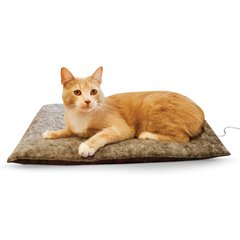How Hot Is Too Hot for Cats?
Nils Jacobi/iStock / Getty Images Plus via Getty Images
Body temperature is regulated by the hypothalamus, a structure within the brain, which establishes the “normal” temperature range.
Cats are warm-blooded and can regulate their body temperature, which averages around 100.5 to 102.5 F. If their ability to change their body temperature is affected, the hypothalamus responds by either trying to conserve body heat through shivering or cooling off through sweating.
However, cats don’t sweat like people do. They often rely instead on other measures of cooling off, like seeking a cooler surface to lie on (conduction cooling) or through evaporative cooling measures, such as panting.
Do Cats Get Overheated?
Yes! Cats can get overheated.
Every veterinary exam includes taking a baseline temperature, which is important, as it can provide several clues about a cat’s health status.
Fever in cats, often defined as temperatures over 103 F, occurs when the normal established temperature per the hypothalamus is reset at a higher range. This often occurs due to an underlying infection, significant inflammation, an immune-mediated disease, or certain kinds of cancers.
Slightly different than fever (pyrexia) is hyperthermia, which occurs with a normal temperature range, but the ability to thermoregulate is affected. Often it is the result of stress, anxiety, strenuous exercise, or hot weather conditions.
Heatstroke is another important cause of hyperthermia (although not as often in cats as dogs). The prognosis of heatstroke in cats is guarded at best and permanent damage to organs or death can occur.
However, being able to distinguish hyperthermia and heatstroke can be quite challenging, and further tests are required to determine the cause of overheating.
What Temperature Is Too Hot for Cats?
Even though fever in cats is defined as a body temperature of 103 F, environmental temperatures greater than 100 F are considered too hot for cats.
Even a few minutes in a locked car on a sunny day can lead to deadly effects.
At temperatures greater than 106 F, cell function becomes affected, which leads to the breaking down of proteins, which results in:
-
Clotting disorders
-
Death
Even a few minutes in a locked car on a sunny day can lead to deadly effects.
What Temperature Is Right for Cats?
The “thermoneutral zone,” or the temperature of a cat’s constant body temperature, is around 86–101 F. Yet, many homes are kept at temperatures quite cooler than that, as the thermoneutral zone for humans is much lower.
As a result, cats can experience cold stress and discomfort, so it is important to provide ample opportunities and spaces for them to warm up. A warm comfortable box, window seat, or cushioned floor mat to soak up the sun’s rays and heating elements are just a few options.
Can Cats Survive the Heat?
Cats can’t survive excessive heat and can die if the temperature is too hot.
Seizures and clotting disorders such as disseminated intravascular coagulation (DIC) are just some of the harmful conditions that can occur, and even if cats recover, there may be lasting effects, such as kidney disease.
How To Tell if Your Cat Is Too Hot
Not all the signs of overheating in cats are obvious, but chances are if you’re too hot, so is your cat. Be sure to seek immediate veterinary attention if your cat develops any of the following signs:
-
Incoordination
-
Tremors or seizures
-
Changes in behavior
-
Heavy breathing, open-mouth breathing, and/or panting
-
Seeking cooler areas or surfaces like a tile floor
-
Bleeding from the nose, gums, or urinary tract
When To Call Your Vet
If you notice any symptoms of overheating in your cat, seek medical attention for them immediately.
If your cat is suffering from overheating, move them into the shade away from direct sunlight and use fans to help them get cooler. Using a cool washcloth, wipe down the cat or put them in a cool bath— just don’t submerge their head. Then bring them to the nearest veterinarian.
How To Keep Your Cat Cool in the Summer
As a responsible pet parent, it is important to ensure the safety of your cat year-round. There are a few things you can do with little effort that have dramatic effects for keeping your cat cool.
As a responsible pet parent, it is important to ensure the safety of your cat year-round. There are a few things you can do with little effort that have dramatic effects for keeping your cat cool.
Fortunately, for many indoor cats with active air conditioning, not much is required, but consider the following:
-
If you take your cat on walks, try shorter walks, and walk during the cooler part of the day, such as early morning or evening.
-
Save play sessions for early morning and evenings to avoid exertion during the hottest parts of the day.
-
Use blinds to help prevent excessive heating of the home.
-
Provide a water fountain to encourage drinking and add ice cubes to the water.
-
Add canned food, as appropriate, to the cat’s diet, as it contains a higher water content than dry food.
-
Utilize cooling mats and frozen treats, such as frozen canned food in puzzle feeders or stuffed Kong® toys, throughout the day.
References
Stella JL, Croney CC. Environmental aspects of domestic cat care and management: Implications for cat welfare. Scientific World Journal. 2016. doi:10.1155/2016/6296315.


